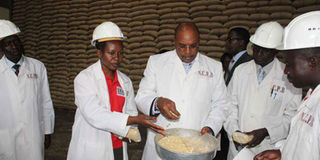Questions continue to be asked about ongoing food crisis

National Cereals and Produce Board of Kenya Chairman Col (Rtd) Geoffrey King'ang'i (centre) at the body's depot in Eldoret on June 28, 2016. PHOTO | STANLEY KIMUGE | NATION MEDIA GROUP
What you need to know:
According to data obtained from Tegemeo Institute of Agricultural Policy and Development, 3 million bags in 1994 would last one-and-half months at a consumption rate of 1 bag for each person.
Today, it would hardly last three weeks since Kenya’s population has grown to 46 million from 26 million in 1994.
Questions continued to be asked on Tuesday about the cause and management of the ongoing food crisis even as it emerged that Kenya has been keeping 3 million bags of maize annually in its strategic food reserve, the same amount it kept 23 years ago.
According to data obtained from Tegemeo Institute of Agricultural Policy and Development, a research body affiliated to Egerton University, 3 million bags in 1994 would last one-and-half months at a consumption rate of 1 bag for each person.
Today, it would hardly last three weeks since Kenya’s population has grown to 46 million from 26 million in 1994.
Commenting on the report, Dr Dennis Otieno, a senior research fellow at Tegemeo, said absence of certainty on the actual consumption per person was a major cause of over and underestimation.
Expanded from the old Strategic Grain Reserve, the Strategic Food Reserve is meant to store maize, pulses, canned beef and powdered milk for reconstitution.
“Allocation to the SFR has not been growing despite policy advice on the same,” the researcher said.
DESPITE KNOWING
Of concern to analysts was the unpreparedness the government has exhibited despite knowing all along that the country did not produce enough grain.
The situation was confounded further this year following the prolonged drought and the maize lethal necrosis disease which has sharply suppressed the crop in the South Rift food basket.
“There is clearly a deficit. And I don’t think anyone is hoarding anything. But it was always clear that we were not producing enough. Production has, more or less, stagnated for the last 20 years yet population has been growing by a million a year,” economist David Ndii explained.
But the timing of maize import, coming less than three months to elections, has raised eyebrows especially given the history of commodity tinkering around poll time.
The Kenya Revenue Authority published a notice allowing importation of duty free maize on May 4 with the commodity arriving at the port on May 10, raising questions over how long it had taken the vessel to sail from Mexico to Mombasa.
Dr Ndii saw the hand of profiteers in the current crisis.




